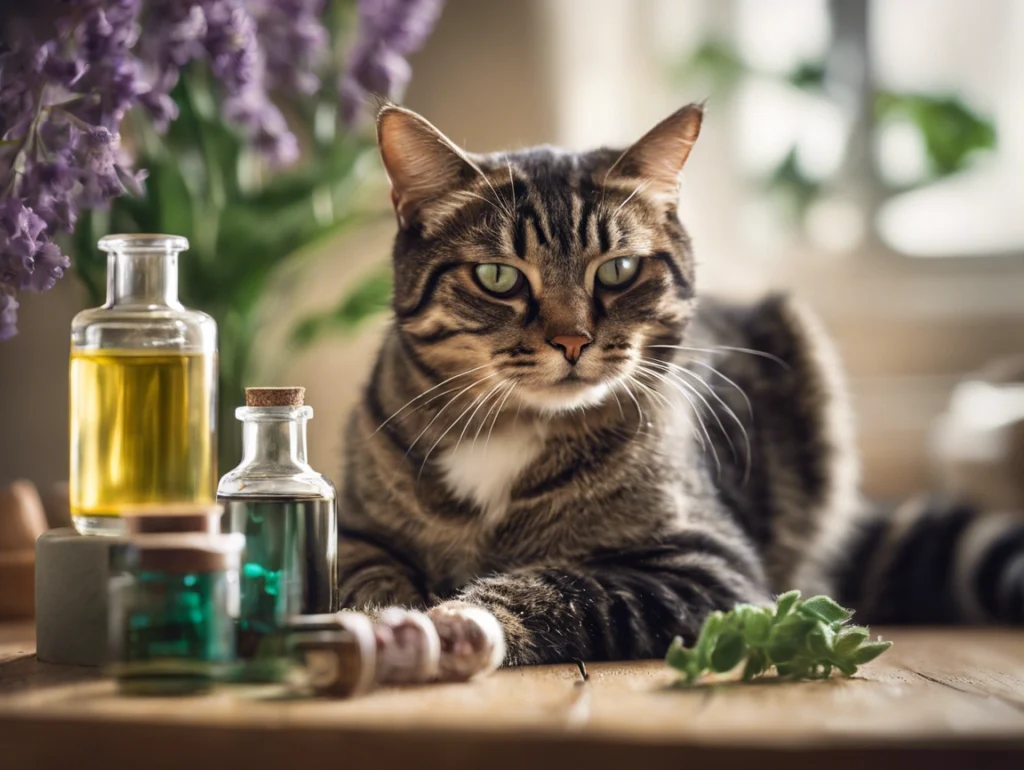Essential oils have gained popularity for their aromatic and therapeutic benefits, but they pose significant risks for cats. Unlike humans and even some other pets, cats have unique metabolic pathways that make them particularly vulnerable to certain compounds found in essential oils. Understanding these dangers and making informed choices can help protect your feline friends.
Why Are Essential Oils Dangerous for Cats?
Cats lack certain liver enzymes, specifically glucuronyl transferase, which are crucial for metabolizing and eliminating certain compounds found in essential oils. One such group of compounds is phenols, and another is compounds like limonene and linalool found in citrus oils. These substances can accumulate in a cat’s system, leading to toxicity. Phenols and citrus compounds are highly concentrated in essential oils and are quickly absorbed through the skin, inhalation, or ingestion, posing a serious threat to cats.
Phenols: The Culprit Behind Essential Oil Toxicity
Phenols are organic compounds that have antiseptic properties and are commonly found in many essential oils. While they offer benefits for humans, they are toxic to cats. Symptoms of phenol toxicity in cats can include drooling, vomiting, tremors, ataxia, respiratory distress, and even liver failure.
Essential Oils High in Phenols (Dangerous for Cats)
- Tea Tree Oil (Melaleuca alternifolia): Even small amounts can cause severe reactions, including central nervous system depression.
- Eucalyptus Oil (Eucalyptus spp.): Highly toxic and can cause respiratory distress, central nervous system depression, liver damage, skin irritation, and severe gastrointestinal distress. Even small amounts, whether inhaled, ingested, or applied to the skin, can lead to serious health issues.
- Cinnamon Oil (Cinnamomum spp.): Can cause liver damage, vomiting, and diarrhea.
- Clove Oil (Syzygium aromaticum): Contains eugenol, which can cause liver toxicity.
- Thyme Oil (Thymus vulgaris): Contains high levels of thymol, which can be harmful to a cat’s liver and central nervous system, potentially leading to symptoms like vomiting, tremors, or seizures.
- Oregano Oil (Origanum vulgare): Rich in phenols such as carvacrol and thymol, which are highly irritating to a cat’s skin and mucous membranes, and can cause gastrointestinal upset, central nervous system depression, and liver damage.
- Peppermint Oil (Mentha piperita): Can cause difficulty breathing and liver failure.
- Wintergreen Oil (Gaultheria procumbens): Contains methyl salicylate, which is similar to aspirin and can be extremely toxic to cats, leading to symptoms such as vomiting, lethargy, rapid breathing, and even organ failure.
- Pine Oil (Pinus spp.): Contains terpenes and phenols, which can cause respiratory distress, vomiting, and central nervous system depression in cats when ingested or inhaled.
- Basil Oil (Ocimum basilicum): While considered less toxic than other oils on the list, basil oil still contains compounds that can cause gastrointestinal upset, such as vomiting and diarrhea, and should be avoided around cats.
These oils are particularly high in phenols and should be kept out of reach of cats. Even diffusing these oils in the home can lead to toxicity if your cat inhales the vapors or comes into contact with surfaces where the oils have settled.
Citrus Essential Oils
Citrus essential oils, including lemon (Citrus limon), orange (Citrus sinensis), lime (Citrus aurantifolia), and grapefruit (Citrus paradisi), are particularly harmful to cats. These oils contain compounds like limonene, linalool, and other chemicals that are highly toxic to felines. Citrus essential oils should be avoided in any form, whether applied topically, diffused, or used in cleaning products.
Symptoms of Citrus Oil Toxicity: Exposure to citrus oils can cause a range of symptoms in cats, including drooling, vomiting, diarrhea, tremors, lethargy, and in severe cases, even liver failure or central nervous system depression. The oils can also cause skin irritation and burns if they come into contact with a cat’s skin.
Inhalation Risks: Inhalation of diffused citrus oils can irritate a cat’s respiratory system, leading to coughing, sneezing, or difficulty breathing. Cats’ respiratory systems are sensitive to strong scents and chemicals, making inhalation of these oils particularly dangerous.
Low Phenol Essential Oils and Their Safety for Cats
Understanding Low Phenol Essential Oils
Low phenol essential oils are those that contain significantly lower concentrations of phenolic compounds compared to others. While they are considered safer than high-phenol oils, it’s important to note that they are not entirely phenol-free. Even in low concentrations, essential oils should be used with caution around cats due to their sensitive metabolism and the risk of toxicity.
Common Low Phenol Essential Oils
1. Lavender Oil (Lavandula angustifolia)
• Properties: Calming, antiseptic, and anti-inflammatory.
• Use with Cats: Lavender oil is often touted as one of the safer essential oils for cats. However, it should still be heavily diluted and used sparingly. Diffusing a small amount in a well-ventilated area is generally considered safe.
2. Chamomile Oil (Matricaria chamomilla)
• Properties: Soothing, anti-inflammatory, and mild sedative.
• Use with Cats: Mild and considered less irritating, chamomile oil can be used for its calming effects but should be diluted and diffused in moderation. It can help alleviate stress and anxiety in cats.
3. Rose Oil (Rosa damascena)
• Properties: Antidepressant, anti-inflammatory, and soothing.
• Use with Cats: Rose oil, when diluted, can be used to create a calm and serene environment. Its low phenol content makes it a safer option, but use caution and avoid direct application.
4. Frankincense Oil (Boswellia carterii)
• Properties: Anti-inflammatory, antiseptic, and calming.
• Use with Cats: Frankincense oil is known for its grounding effects. It can be diffused in small amounts to promote a peaceful atmosphere. Generally regarded as safer than many other essential oils but should still be used cautiously. Ensure it is diluted and monitor your cat for any adverse reactions.
5. Cedarwood Oil (Cedrus atlantica)
• Properties: Antifungal, antiseptic, and calming.
• Use with Cats: Cedarwood oil can be used in small, diluted quantities. It is often used to repel insects naturally. Diffuse it sparingly in areas where your cat can avoid it if they choose.
Are These Oils Phenol-Free?
No, these essential oils are not completely phenol-free. They contain lower concentrations of phenols compared to high-phenol oils like tea tree or clove oil. While they pose a lower risk, it is crucial to use them carefully and always prioritize your cat’s safety by monitoring their reactions. Always dilute essential oils heavily and avoid direct contact with your cat’s skin or fur. Diffusion should be done in well-ventilated areas, and cats should have the option to leave the room if they are uncomfortable.
Companies and Phenol-Free Essential Oils
Currently, there are no commercial processes specifically designed to remove phenols from essential oils while retaining their beneficial properties. Instead, the focus is on selecting oils with naturally low phenol content and using them safely.
Safe Practices for Using Low Phenol Oils Around Cats
- Avoid Direct Application: Never apply essential oils directly to your cat’s skin or fur. Cats are fastidious groomers and can ingest oils during grooming.
- Dilution is Key: Essential oils should be heavily diluted if used around cats. Even oils that are generally considered safer can cause issues in higher concentrations. Use only a few drops of essential oil in a large quantity of water. A safe dilution ratio for cats is typically one drop of essential oil per 50-100 ml of carrier oil (like coconut or olive oil).
- Diffusion: If you choose to diffuse essential oils, do so in a well-ventilated area so that your cat is not trapped in an enclosed space with the diffuser.
- Limit Exposure Time: Only diffuse oils for short periods and always observe your cat for any signs of distress, such as coughing, sneezing, or lethargy.
- Observation: Monitor your cat closely for any signs of distress or adverse reactions, such as drooling, vomiting, difficulty breathing, or lethargy. Discontinue use immediately if any symptoms occur.
- Storage: Store essential oils securely out of reach of pets.
Product Recommendations
Pet-Safe Diffusers: Look for diffusers designed to disperse essential oils at a low concentration over a larger area, reducing the risk of exposure. Use ultrasonic diffusers rather than nebulizing ones. Ultrasonic diffusers release smaller amounts of essential oil into the air, reducing the risk of exposure.
Pet-Safe Cleaning Products: Use pet-safe cleaning products that do not contain essential oils, especially phenol-containing oils.
Pet-Friendly Brands: For flea control, we like to make our own, or rely on Wondercide for cat-friendly options.
Herbal Alternatives: Consider using dried herbs or herbal hydrosols, which are safer alternatives to essential oils. Hydrosols contain only a fraction of the concentrated compounds found in essential oils, making them gentler and less likely to cause adverse reactions in cats. With their milder aromas and therapeutic benefits, hydrosols offer a more cat-friendly way to enjoy the essence of plants, however still steer clear of the dangerous list of herbs as phenols are still present in hydrosols, just in much less concentration.
To Wrap It Up
While essential oils can offer various benefits for humans, they pose significant dangers to cats due to their inability to metabolize certain compounds like phenols. Even though low-phenol essential oils like lavender, chamomile, rose, frankincense, and cedarwood are considered safer options, they must still be used with caution around cats. Understanding the risks and practicing safe usage can help protect your feline companions from the potential dangers of essential oils

